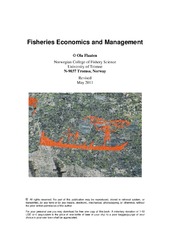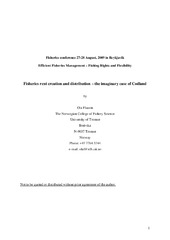Blar i tittel Artikler, rapporter og annet (Norges fiskerihøgskole)
Viser treff 351-370 av 929
-
Fisheries economics and management
(Book; Bok, 2011-05) -
Fisheries Management and Global Warming. Effects of climate change on fisheries in the Arctic region of the Nordic countries.
(Research report; Forskningsrapport, 2014) -
Fisheries rent creation and distribution – the imaginary case of Codland
(Conference object; Konferansebidrag, 2009-08-27)This paper discusses actual and possible achievements and failures of Codland and examines it from the point of view of efficiency and in terms of distribution. It is argued in favour of the joint analysis of the two approaches when contemplating fisheries management reforms, since such reforms may create both winners and losers. The analysis demonstrates how rent drain from fishing communities and ... -
The Fisheries Sector in Ghana: A Political Economy Analysis
(Research report; Forskningsrapport, 2018-12-04)The fishery sector of Ghana is beset with problems, including widespread illegal, unreported and unregulated fishing.This report analyses the political economy of fisheries in Ghana, focusing on the power and interests of key actors in the sector and the constraints and opportunities faced by the government in addressing the existing challenges. There are three main challenges facing the sector. ... -
Fishes in a changing world: learning from the past to promote sustainability of fish populations
(Journal article; Tidsskriftartikkel; Peer reviewed, 2018-03-14)Populations of fishes provide valuable services for billions of people, but face diverse and interacting threats that jeopardize their sustainability. Human population growth and intensifying resource use for food, water, energy and goods are compromising fish populations through a variety of mechanisms, including overfishing, habitat degradation and declines in water quality. The important ... -
Fishing efficiency of biodegradable PBSAT gillnets and conventional nylon gillnets used in Norwegian cod (Gadus morhua) and saithe (Pollachius virens) fisheries
(Journal article; Tidsskriftartikkel; Peer reviewed, 2018-09-10)Fishing trials were carried out to compare the relative fishing efficiency of gillnets made of a new biodegradable resin (polybutylene succinate co-adipate-co-terephthalate, PBSAT) with conventional (nylon) nets. The fishing trials covered two consecutive fishing seasons (2016 and 2017) for cod (<i>Gadus morhua</i>) and saithe (<i>Pollachius virens</i>) in northern Norway. Results generally showed ... -
Fishing for mammals: Landscape‐level monitoring of terrestrial and semi‐aquatic communities using eDNA from riverine systems
(Journal article; Tidsskriftartikkel; Peer reviewed, 2020-03-10)1: Environmental DNA (eDNA) metabarcoding has revolutionized biomonitoring in both marine and freshwater ecosystems. However, for semi‐aquatic and terrestrial animals, the application of this technique remains relatively untested.<p> <p>2: We first assess the efficiency of eDNA metabarcoding in detecting semi‐aquatic and terrestrial mammals in natural lotic ecosystems in the UK by comparing ... -
Fiskeren fra veidemann til "advokat"
(Chapter; Bokkapittel, 2002) -
Fiskeridirektøren bør flyttes til Tromsø
(Journal article; Tidsskriftartikkel, 2016-11-17)Fiskeridirektøren og det tilknyttede reguleringsutvalget og forvaltningsorganene flyttes fra Bergen til Tromsø, i det minste den delen som angår forvaltningen av ressursene utenfor Nord Norge, foreslår artikkelforfatterne. -
Fiskeripolitikkens konsekvenser på kysten
(Chronicle; Kronikk, 2016-09-09) -
Flashing light emitting diodes (LEDs) induce proteins, polyunsaturated fatty acids and pigments in three microalgae
(Journal article; Tidsskriftartikkel; Peer reviewed, 2020-11-25)As the periodic emission of light pulses by light emitting diodes (LEDs) is known to stimulate growth or induce high value biocompounds in microalgae, this flashing light regime was tested on growth and biochemical composition of the microalgae <i>Nannochloropsis gaditana, Koliella antarctica</i> and <i>Tetraselmis chui</i>. At low flashing light frequencies (e.g., 5 and 50 Hz, Duty cycle = 0.05), ... -
Flashing lights affect the photophysiology and expression of carotenoid and lipid synthesis genes in Nannochloropsis gaditana
(Journal article; Tidsskriftartikkel; Peer reviewed, 2022-11-20)Nannochloropsis gaditana is a promising microalga for biotechnology. One of the strategies to stimulate its full potential in metabolite production is exposure to flashing lights. Here, we report how N. gaditana adapts to different flashing light regimes (5, 50, and 500 Hz) by changing its cellular physiology and the relative expression of genes related to critical cellular functions. We analyzed ... -
Flashing lights affect the photophysiology and expression of carotenoid and lipid synthesis genes in Nannochloropsis gaditana
(Journal article; Tidsskriftartikkel; Peer reviewed, 2022-11-20)Nannochloropsis gaditana is a promising microalga for biotechnology. One of the strategies to stimulate its full potential in metabolite production is exposure to flashing lights. Here, we report how N. gaditana adapts to different flashing light regimes (5, 50, and 500 Hz) by changing its cellular physiology and the relative expression of genes related to critical cellular functions. We analyzed ... -
Food and chemical substances relevant for monitoring - Scientific Opinion of the Scientific Steering Committee of the Norwegian Scientific Committee for Food and Environment
(Research report; Forskningsrapport, 2022-06-09) -
Food and chemical substances relevant for monitoring. Report from the Scientific Steering Committee of the Norwegian Scientific Committee for Food and Environment.
(Research report; Forskningsrapport, 2022)At request from the Norwegian Food Safety Authority (NFSA), VKM has identified food groups and food items consumed by the Norwegian population that are relevant for monitoring regarding content of one or more undesirable chemical substances (Figure 1). Undesirable chemical substances were defined as chemical substances in food that may constitute a potential health risk.<p> <p>VKM has created ... -
Food as a commodity, human right or common good
(Journal article; Tidsskriftartikkel; Peer reviewed, 2021-03-11)The European Commission’s recently published ‘Farm to Fork’ strategy seeks to facilitate a transition towards a sustainable food system. The strategy moves from a linear understanding of the food system towards a more circular view of the system’s complex interdependencies. Despite these laudable intentions, it does not follow the guidance of the EU’s Group of Chief Scientific Advisors that the ... -
Food Safety Risks Posed by Heavy Metals and Persistent Organic Pollutants (POPs) related to Consumption of Sea Cucumbers
(Journal article; Tidsskriftartikkel; Peer reviewed, 2022-12-09)The global production of sea cucumbers was 245 thousand tons in 2020. Sea cucumbers are important food items in Asian and Pacific cuisines, the highest proportion being consumed in China as “bêche-de-mer” dried, gutted, boiled and salted body wall. However, consumption of sea cucumbers is expanding in China and globally, and the high demand has led to decline in populations of sea cucumbers, due to ... -
Food-web structure varies along environmental gradients in a high-latitude marine ecosystem
(Journal article; Tidsskriftartikkel; Peer reviewed, 2018-05-17)Large-scale patterns in species diversity and community composition are associated with environmental gradients, but the implications of these patterns for food-web structure are still unclear. Here, we investigated how spatial patterns in food-web structure are associated with environmental gradients in the Barents Sea, a highly productive shelf sea of the Arctic Ocean. We compared food webs ... -
For all audiences: Incorporating immature stages into standardised spider inventories has a major impact on the assessment of biodiversity patterns
(Journal article; Tidsskriftartikkel; Peer reviewed, 2022-04-25)Although arthropods are the largest component of animal diversity, they are traditionally underrepresented in biological inventories and monitoring programmes. However, no biodiversity assessment can be considered informative without including them. Arthropod immature stages are often discarded during sorting, despite frequently representing more than half of the collected individuals. To date, ... -
Forfeiting the priority effect: turnover defines biofilm community succession
(Journal article; Tidsskriftartikkel; Peer reviewed, 2019-03-18)Microbial community succession is a fundamental process that affects underlying functions of almost all ecosystems; yet the roles and fates of the most abundant colonizers are often poorly understood. Does early abundance spur long term persistence? How do deterministic and stochastic processes influence the ecological contribution of colonizers? We performed a succession experiment within a hypersaline ...


 English
English norsk
norsk


















